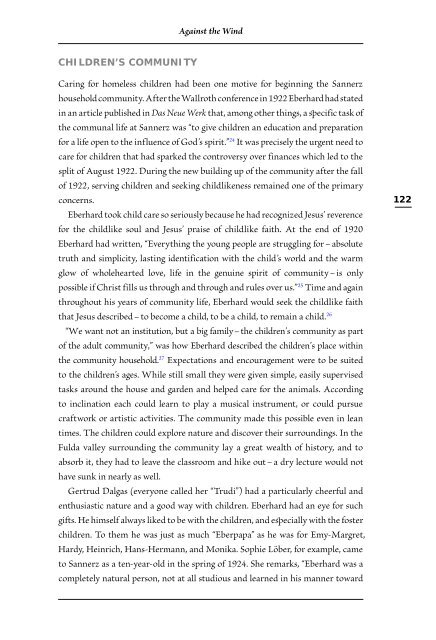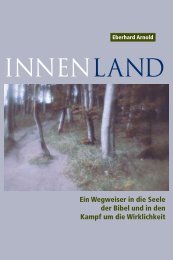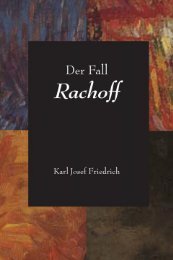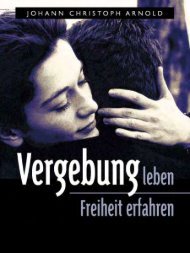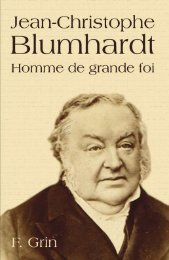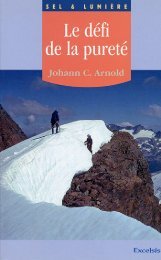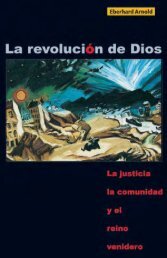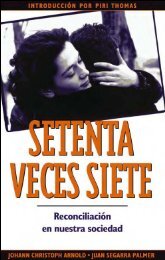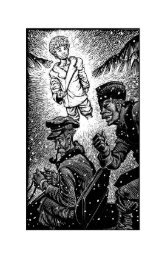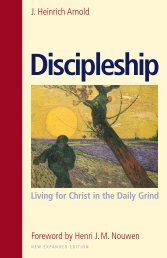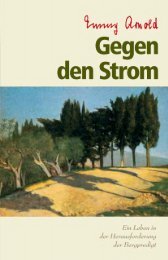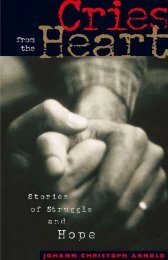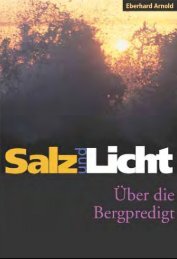Against the Wind: Eberhard Arnold and the Bruderhof - Plough
Against the Wind: Eberhard Arnold and the Bruderhof - Plough
Against the Wind: Eberhard Arnold and the Bruderhof - Plough
Create successful ePaper yourself
Turn your PDF publications into a flip-book with our unique Google optimized e-Paper software.
ChildrEn’S Community<br />
<strong>Against</strong> <strong>the</strong> <strong>Wind</strong><br />
Caring for homeless children had been one motive for beginning <strong>the</strong> Sannerz<br />
household community. After <strong>the</strong> Wallroth conference in 1922 <strong>Eberhard</strong> had stated<br />
in an article published in Das Neue Werk that, among o<strong>the</strong>r things, a secific task of<br />
<strong>the</strong> communal life at Sannerz was “to give children an education <strong>and</strong> preparation<br />
for a life open to <strong>the</strong> influence of God’s spirit.” 24 It was precisely <strong>the</strong> urgent need to<br />
care for children that had sparked <strong>the</strong> controversy over finances which led to <strong>the</strong><br />
split of August 1922. During <strong>the</strong> new building up of <strong>the</strong> community after <strong>the</strong> fall<br />
of 1922, serving children <strong>and</strong> seeking childlikeness remained one of <strong>the</strong> primary<br />
concerns. 122<br />
<strong>Eberhard</strong> took child care so seriously because he had recognized Jesus’ reverence<br />
for <strong>the</strong> childlike soul <strong>and</strong> Jesus’ praise of childlike faith. At <strong>the</strong> end of 1920<br />
<strong>Eberhard</strong> had written, “Everything <strong>the</strong> young people are struggling for – absolute<br />
truth <strong>and</strong> simplicity, lasting identification with <strong>the</strong> child’s world <strong>and</strong> <strong>the</strong> warm<br />
glow of wholehearted love, life in <strong>the</strong> genuine spirit of community – is only<br />
possible if Christ fills us through <strong>and</strong> through <strong>and</strong> rules over us.” 25 Time <strong>and</strong> again<br />
throughout his years of community life, <strong>Eberhard</strong> would seek <strong>the</strong> childlike faith<br />
that Jesus described – to become a child, to be a child, to remain a child. 26<br />
“We want not an institution, but a big family – <strong>the</strong> children’s community as part<br />
of <strong>the</strong> adult community,” was how <strong>Eberhard</strong> described <strong>the</strong> children’s place within<br />
<strong>the</strong> community household. 27 Expectations <strong>and</strong> encouragement were to be suited<br />
to <strong>the</strong> children’s ages. While still small <strong>the</strong>y were given simple, easily supervised<br />
tasks around <strong>the</strong> house <strong>and</strong> garden <strong>and</strong> helped care for <strong>the</strong> animals. According<br />
to inclination each could learn to play a musical instrument, or could pursue<br />
craftwork or artistic acivities. The community made this possible even in lean<br />
times. The children could explore nature <strong>and</strong> discover <strong>the</strong>ir surroundings. In <strong>the</strong><br />
Fulda valley surrounding <strong>the</strong> community lay a great wealth of history, <strong>and</strong> to<br />
absorb it, <strong>the</strong>y had to leave <strong>the</strong> classroom <strong>and</strong> hike out – a dry lecture would not<br />
have sunk in nearly as well.<br />
Gertrud Dalgas (everyone called her “Trudi”) had a particularly cheerful <strong>and</strong><br />
enthusiastic nature <strong>and</strong> a good way with children. <strong>Eberhard</strong> had an eye for such<br />
gifts. He himself always liked to be with <strong>the</strong> children, <strong>and</strong> esecially with <strong>the</strong> foster<br />
children. To <strong>the</strong>m he was just as much “Eberpapa” as he was for Emy-Margret,<br />
Hardy, Heinrich, Hans-Hermann, <strong>and</strong> Monika. Sophie Löber, for example, came<br />
to Sannerz as a ten-year-old in <strong>the</strong> spring of 1924. She remarks, “<strong>Eberhard</strong> was a<br />
completely natural person, not at all studious <strong>and</strong> learned in his manner toward


